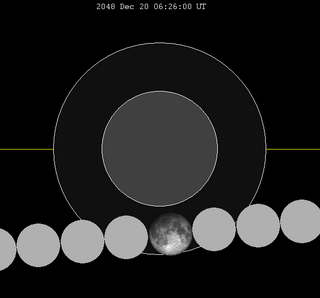| Penumbral eclipse | |||||||||
 | |||||||||
| Date | 17 May 2049 | ||||||||
|---|---|---|---|---|---|---|---|---|---|
| Gamma | −1.1337 | ||||||||
| Magnitude | 0.7638 [1] | ||||||||
| Saros cycle | 112 (67 of 72 [2] ) | ||||||||
| Penumbral | 224 minutes 16 seconds | ||||||||
| |||||||||
A penumbral lunar eclipse will take place on May 17, 2049.
| Penumbral eclipse | |||||||||
 | |||||||||
| Date | 17 May 2049 | ||||||||
|---|---|---|---|---|---|---|---|---|---|
| Gamma | −1.1337 | ||||||||
| Magnitude | 0.7638 [1] | ||||||||
| Saros cycle | 112 (67 of 72 [2] ) | ||||||||
| Penumbral | 224 minutes 16 seconds | ||||||||
| |||||||||
A penumbral lunar eclipse will take place on May 17, 2049.
| Ascending node | Descending node | |||||
|---|---|---|---|---|---|---|
| Saros | Date Viewing | Type Chart | Saros | Date Viewing | Type Chart | |
| 112 | 2049 May 17  | Penumbral | 117 | 2049 Nov 09  | Penumbral | |
| 122 | 2050 May 06  | Total | 127 | 2050 Oct 30  | Total | |
| 132 | 2051 Apr 26  | Total | 137 | 2051 Oct 19  | Total | |
| 142 | 2052 Apr 14  | Penumbral | 147 | 2052 Oct 08  | Partial | |
| Last set | 2049 Jun 15 | Last set | 2048 Dec 20 | |||
| Next set | 2053 Aug 29 | Next set | 2053 Mar 04 | |||
Lunar Saros series 112, repeating every 18 years and 11 days, has a total of 72 lunar eclipse events including 15 total lunar eclipses.
| Greatest | First | |||
|---|---|---|---|---|
| The greatest eclipse of the series occurred on 1490 Jun 02, lasting 100 minutes. [3] | Penumbral | Partial | Total | Central |
| 859 May 20 | 985 Aug 03 | 1364 Mar 18 | 1436 Apr 30 | |
| Last | ||||
| Central | Total | Partial | Penumbral | |
| 1562 Jul 16 | 1616 Aug 27 | 2013 Apr 25  | 2139 Jul 12 | |
There are 11 series events between 1901 and 2100, grouped into threes (called an exeligmos), each column with approximately the same viewing longitude on Earth.
| 1905 Feb 19 | 1923 Mar 3 | 1941 Mar 13 | |||
 |  |  |  |  |  |
| 1959 Mar 24 | 1977 Apr 04 | 1995 Apr 15 | |||
 |  |  |  |  |  |
| 2013 Apr 25 | 2031 May 07 | 2049 May 17 | |||
 |  |  |  |  |  |
| 2067 May 28 | 2085 Jun 08 | ||||
 |  | ||||
A lunar eclipse will be preceded and followed by solar eclipses by 9 years and 5.5 days (a half saros). [4] This lunar eclipse is related to two partial solar eclipses of Solar Saros 119.
| May 11, 2040 | May 22, 2058 |
|---|---|
 |  |

A total lunar eclipse will take place on July 7, 2047. It will last 1 hour 40 minutes and 49 seconds and will plunge the full Moon into deep darkness, as it passes right through the centre of the Earth's umbral shadow. While the visual effect of a total eclipse is variable, the Moon may be stained a deep orange or red colour at maximum eclipse. This will be a great spectacle for everyone who sees it. The partial eclipse will last for 3 hours and 39 minutes in total.

A partial lunar eclipse took place on Saturday, April 15, 1995, the first of two lunar eclipses in 1995, the second being with a penumbral lunar eclipse on Sunday, October 8.
A penumbral lunar eclipse took place on Tuesday, January 20, 1981, the first of two lunar eclipses in 1981. In a rare total penumbral eclipse, the entire Moon was partially shaded by the Earth, and the shading across the Moon should have been quite visible at maximum eclipse. The penumbral phase lasted for 4 hours and 24 minutes in all, though for most of it, the eclipse was extremely difficult, if not impossible to see. The moon's apparent diameter was larger because the eclipse occurred 5.2 days after perigee.
A partial lunar eclipse took place on Monday, April 4, 1977, the first of two lunar eclipses in 1977. Lasting 1 hour and 34.76 minutes, 19.289% of the Moon was in shadow at maximum.

A penumbral lunar eclipse will take place on May 7, 2031.

A penumbral lunar eclipse will take place on June 15, 2049.

A total lunar eclipse will take place on January 1, 2048. It will be the first recorded lunar eclipse to be visible on New Year's Day for nearly all of Earth's timezones. The next such eclipse will occur in 2094.

A partial lunar eclipse will take place on January 22, 2046.

A penumbral lunar eclipse will take place on March 3, 2045.

A total lunar eclipse will take place on September 19, 2043.

A total lunar eclipse will take place on September 7, 2044. It will be the first total eclipse in Lunar Saros 138.

A total lunar eclipse will take place on March 13, 2044.

A total lunar eclipse will take place on March 25, 2043.

A partial lunar eclipse will take place on July 18, 2046.

A penumbral lunar eclipse will take place on December 20, 2048.

A partial lunar eclipse will take place on June 26, 2048. The Moon will be strikingly shadowed in this deep partial eclipse lasting 2 hours and 39 minutes, with 63.88% of the Moon in darkness at maximum.

A total lunar eclipse will take place on January 12, 2047.

A penumbral lunar eclipse will take place on November 9, 2049.

A total lunar eclipse will take place on April 26, 2051.

A total lunar eclipse will take place on October 30, 2050.